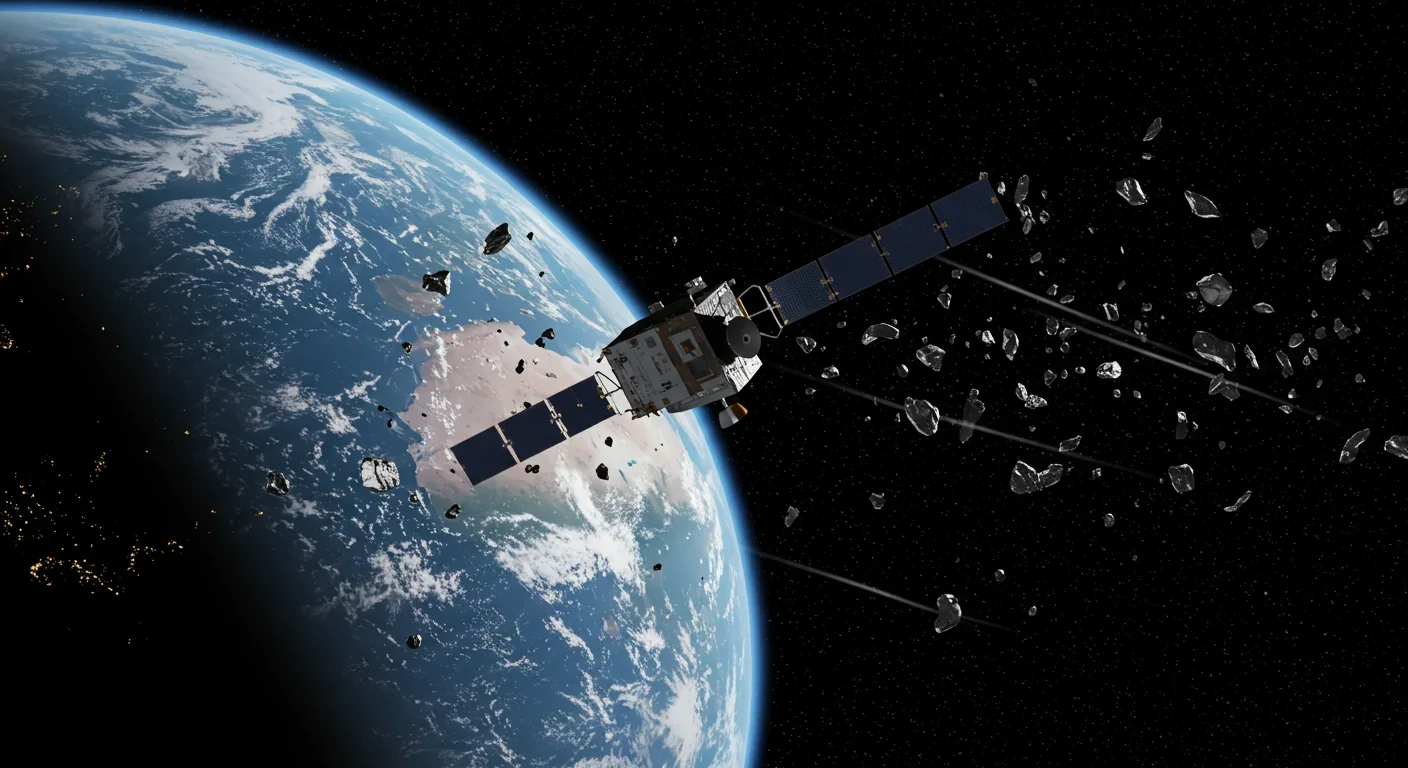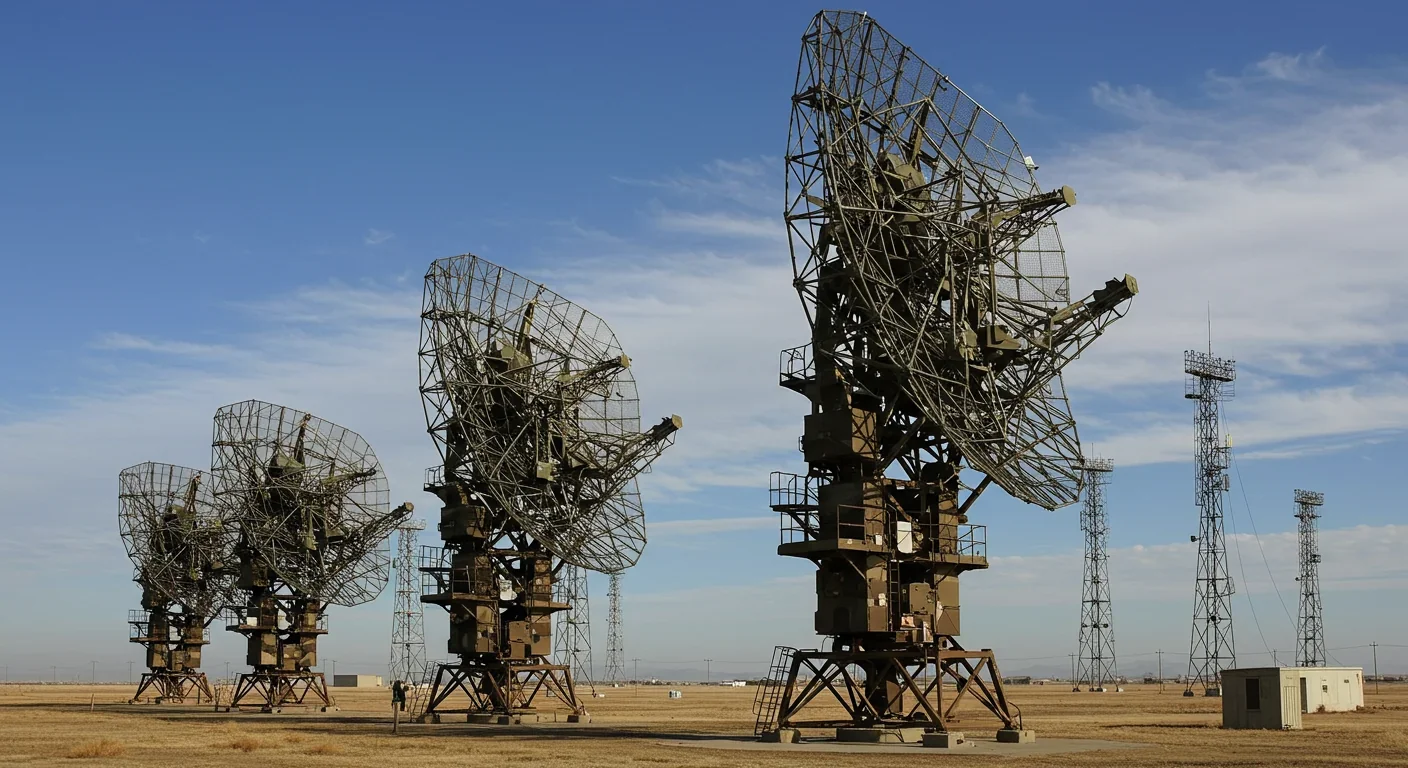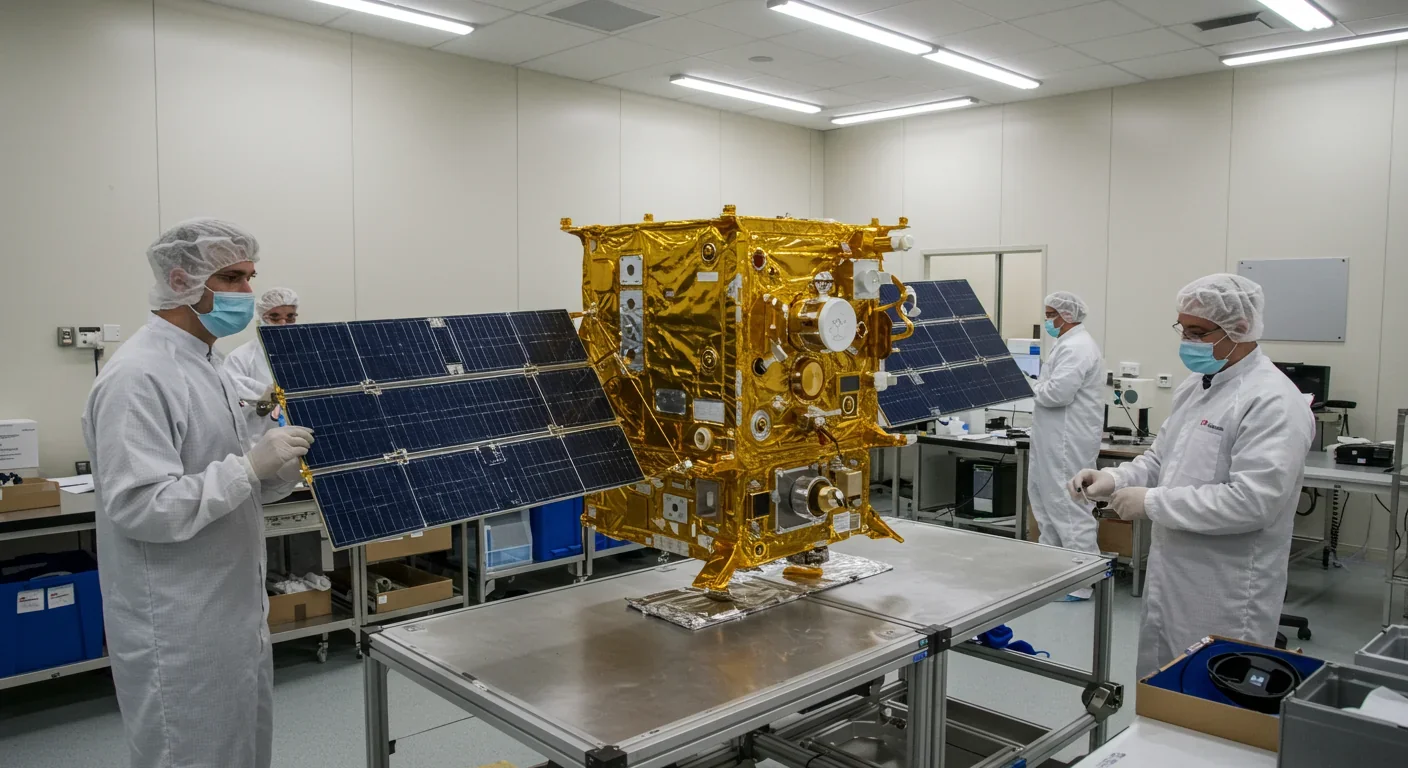Fusion Rockets Could Reach 10% Light Speed: The Breakthrough

TL;DR: Space warfare has evolved from theory to reality, with nations deploying anti-satellite weapons while outdated treaties fail to keep pace. The stakes are civilization-level: orbital conflicts could trigger debris cascades that lock humanity on Earth for generations.

Picture this: a single explosion in orbit, and within 24 hours, hundreds of satellites go dark. GPS fails. Financial transactions halt. Weather forecasts vanish. Military communications collapse. This isn't science fiction anymore. As humanity pushes deeper into space, we're racing toward a future where orbital conflicts could cascade into civilization-altering disasters. The question isn't whether space will become a battlefield, it's whether we'll write the rules before the first shots are fired.
Space warfare has evolved from Cold War fantasies into stark reality. Unlike past military domains, space offers no natural barriers, no borders, no safe harbors. When China demonstrated its anti-satellite capabilities in 2007 by destroying one of its own weather satellites, the test created over 3,000 trackable debris fragments that will threaten spacecraft for decades. That single event proved a chilling point: destroying assets in space is easy. Protecting them is nearly impossible.
Today's space arsenals include technologies that sound lifted from science fiction. Kinetic kill vehicles ram targets at orbital speeds, turning physics itself into a weapon. Directed-energy weapons can blind or burn satellite sensors from thousands of miles away. Electronic warfare systems jam communications or spoof GPS signals. Russia has tested co-orbital satellites that shadow potential targets, ready to strike on command.
The U.S. Space Force recently declared its ATLAS system operational, a space domain awareness platform that tracks thousands of objects in real-time. Yet tracking threats and stopping them remain vastly different challenges. As one defense analyst put it, we're developing eyes in space faster than we're developing shields.
The 1967 Outer Space Treaty, signed during the Apollo era, banned weapons of mass destruction in orbit but said nothing about conventional weapons. That omission has haunted us ever since. The treaty assumed space would remain peaceful because reaching orbit was so difficult. Today, over 80 countries have space capabilities, and commercial companies launch rockets weekly.
International law currently treats space like the high seas: open to all, owned by none. But unlike oceans, space debris doesn't sink or disperse. Every collision creates fragments traveling at 17,000 miles per hour, each one a potential bullet. Legal scholars call this the Kessler Syndrome nightmare, where debris collisions create more debris in an unstoppable cascade, eventually making entire orbital zones unusable.
Recent diplomatic efforts have barely scratched the surface. The United States and several allies pledged to stop destructive anti-satellite tests, a positive step. Yet Russia and China haven't joined, and voluntary commitments lack enforcement mechanisms. Without consequences, pledges become suggestions. Without verification, trust becomes impossible.
The UN's efforts to update space law move glacially. Proposed frameworks for "norms of responsible behavior" sound promising until you realize they're non-binding resolutions that major powers routinely ignore. Meanwhile, the technology races ahead. By the time diplomats agree on banning a specific weapon type, military engineers have often moved on to the next generation.
Modern space weapons divide into three categories: kinetic, directed-energy, and electronic. Each poses unique threats and countermeasures.
Kinetic weapons are brutally simple. Launch something at a satellite moving 17,000 mph, and the resulting impact releases energy equivalent to a car bomb. Direct-ascent missiles, fired from Earth, can reach low-orbit targets in minutes. Co-orbital systems take longer but offer precision, shadowing targets for weeks before striking. China's HQ-29 missile system reportedly combines both approaches, adding a hypersonic layer that makes interception almost impossible.
Directed-energy weapons offer a cleaner alternative. High-power lasers can dazzle optical sensors, temporarily blinding reconnaissance satellites, or burn through solar panels and electronics with sustained exposure. China's LY-1 laser system, unveiled at a 2019 military parade, demonstrated this capability publicly. The advantage? No debris field. The challenge? Atmospheric distortion limits effectiveness from ground-based systems.
Electronic warfare might be the most insidious threat. GPS spoofing can mislead navigation systems. Communications jamming can isolate military forces. Cyber intrusions can hijack satellites entirely. These attacks leave no physical evidence, making attribution nearly impossible. Did your satellite malfunction, or did someone hack it? The ambiguity itself becomes a weapon.

Defending space assets requires rethinking everything we know about military protection. Traditional defenses like armor or evasion barely work in orbit. Armor adds weight that costs millions to launch. Evasive maneuvers consume fuel that satellites carry in limited supply.
Instead, modern defense strategies emphasize resilience through numbers. Rather than deploying a few expensive satellites, operators launch hundreds of smaller, cheaper ones in proliferated constellations. If adversaries destroy ten satellites, the network barely notices. This approach, called "resilience by design," mirrors how the internet routes around damage.
Hardening satellites against attack offers another layer of protection. Engineers design systems to withstand radiation, survive laser attacks for limited periods, and detect electronic intrusions. But hardening adds cost and weight, creating difficult tradeoffs. Do you armor your reconnaissance satellite and sacrifice resolution, or maximize capability and accept vulnerability?
Space domain awareness has become the foundation of all defense efforts. If you can't track threats, you can't avoid them. The ATLAS system L3Harris developed for the Space Force processes data from ground-based radars, telescopes, and other satellites to create a real-time picture of everything in orbit. Think of it as air traffic control for the cosmos, tracking objects as small as a softball across millions of cubic miles.
Active defense systems remain controversial. Can you shoot down an incoming missile without creating more debris? Can you grapple and deorbit a threatening satellite without triggering an international incident? Sierra Space recently announced plans for satellites equipped with interceptor missiles, raising precisely these questions. Where does defense end and aggression begin?
Real-world incidents illustrate the stakes. In 2007, China's anti-satellite test destroyed the Fengyun-1C weather satellite, creating the largest debris field in history. Fragments from that test have forced the International Space Station to perform evasive maneuvers multiple times. A test conducted over a decade ago still threatens astronauts today.
Russia's 2021 test followed a similar pattern, destroying its own Cosmos 1408 satellite and forcing ISS crew members into escape capsules as precaution. The message was clear: we can hit your satellites if we want to. The debris was collateral damage, an acceptable price for demonstrating capability.
India joined the club in 2019 with Operation Shakti, destroying a satellite in low orbit. Unlike previous tests, India chose a lower altitude to minimize long-term debris concerns. Still, hundreds of fragments remained in orbit for months. The international response was muted, countries recognize the hypocrisy of condemning tests they've conducted themselves.
Not all incidents involve intentional destruction. In 2009, an inactive Russian satellite collided with an operational U.S. communications satellite over Siberia, creating thousands of debris fragments from pure accident. As orbits grow more crowded with commercial mega-constellations like Starlink, such accidents will become more frequent unless traffic management dramatically improves.
Even cleanup efforts raise military concerns. Technologies designed to remove debris could easily double as weapons. A spacecraft with a robotic arm for collecting junk could just as easily grab a functioning satellite. Japan's experimental plasma thruster, designed to push debris into decay orbits, could theoretically target operational spacecraft. The dual-use nature of space technology makes arms control agreements nightmarishly complex.
The implications of space warfare extend far beyond military concerns. Modern civilization depends on space infrastructure in ways most people never consider. Weather satellites inform farming decisions affecting global food supply. GPS enables not just navigation but precise timing for financial transactions, power grids, and telecommunications networks. Communications satellites connect remote regions to education, healthcare, and economic opportunity.
Losing this infrastructure wouldn't just impact military operations. It would cascade through society. Supply chains would fracture without satellite logistics tracking. Agriculture would struggle without precision farming data. Disaster response would slow without satellite communications and imaging. Financial markets might freeze without GPS-synchronized trading systems.
The economic dimension is staggering. The satellite industry generates over $270 billion annually, supporting millions of jobs. But beyond direct industry employment, satellite services enable trillions in economic activity. One analysis suggested a month-long GPS outage could cost the U.S. economy $1 billion daily. Multiply that across global markets and the numbers become astronomical.
Environmental consequences add another layer of concern. Orbital debris doesn't respect borders. An attack by one nation creates hazards for all. The Kessler Syndrome scenario could effectively lock humanity on Earth, making spaceflight too dangerous for generations. We'd sacrifice not just satellite services but the long-term future of space exploration.

Private companies have transformed the space equation faster than governments anticipated. SpaceX launches more satellites than most countries combined. Amazon plans to deploy thousands of broadband satellites. Companies in China, Europe, and elsewhere race to build their own mega-constellations.
This commercialization brings new vulnerabilities and new actors. Unlike military satellites built to withstand attacks, commercial spacecraft prioritize cost and capability. They're easier targets. Yet they're also more numerous, harder to eliminate completely. An adversary might destroy a handful of military reconnaissance satellites, but could they take down thousands of commercial communications satellites before losing international support?
Commercial operators also complicate escalation management. If a SpaceX satellite is destroyed, does that constitute an attack on the United States? On a private company? What if the satellite was serving government customers? The line between civilian and military blurs in orbit more than anywhere else.
On the positive side, commercial innovation drives down costs and accelerates deployment timelines. Technologies once affordable only to superpowers are now within reach of smaller nations and private actors. This democratization could foster transparency; harder to prepare surprise attacks when dozens of commercial satellites watch every launch. Or it could enable new threats, lowering barriers for non-state actors to acquire space capabilities.
Expert recommendations converge on several key points. First, establish clear red lines and consequences. Voluntary commitments aren't enough; nations need to know that attacking certain satellites will trigger specific responses. Ambiguity encourages testing limits.
Second, create verification mechanisms. Trust-but-verify worked for Cold War nuclear treaties because both sides could monitor compliance. Space needs similar transparency, perhaps through international inspection regimes or shared sensor data.
Third, incentivize debris reduction. Make debris-creating weapons taboo through naming-and-shaming campaigns. Consider economic sanctions for tests that create long-lived debris fields. Reward nations that help clean up existing debris.
Fourth, separate civilian and military infrastructure clearly. Dual-use satellites complicate targeting decisions and escalation management. While some overlap is inevitable, clearer distinctions could reduce miscalculation risks.
Fifth, expand the conversation beyond traditional space powers. When only a few nations had space capabilities, negotiations stayed small. Today's reality demands inclusive forums where new space nations have voice in rule-making.
Looking ahead, some analysts advocate for demilitarizing certain orbital zones entirely, creating protected regions for critical civilian infrastructure. Others propose "rules of engagement" for space, similar to maritime law, defining when self-defense becomes justified. Still others suggest economic approaches, using insurance requirements and liability frameworks to discourage risky behavior.
We stand at a civilizational decision point. One path leads toward space as a contested domain, where periodic conflicts create debris fields that gradually choke off orbital access. Nations and companies spend billions on defensive measures and replacement satellites in an endless cycle. The long-term vision of space exploration and development remains perpetually just beyond reach, sacrificed to immediate security concerns.
The other path recognizes space as a shared resource requiring collective management. International frameworks enforce consequences for debris creation. Transparency measures reduce miscalculation risks. Civilian infrastructure receives protected status. Military presence continues but within agreed boundaries. Humanity maintains the orbital access needed for both security and progress.
Which path we choose depends on decisions made in the next few years, before the first real conflict writes the rules in blood and debris. The technology exists to devastate orbital infrastructure. The question is whether we'll develop the wisdom to prevent it.
Every satellite launched, every treaty negotiated, every weapon deployed pushes us toward one future or the other. The choices belong to policymakers and military planners today, but the consequences will echo through generations. Our grandchildren will either thank us for preserving their access to space, or curse us for the orbital prison we built around Earth.
Space warfare isn't coming. It's here. What happens next is up to us.

Recent breakthroughs in fusion technology—including 351,000-gauss magnetic fields, AI-driven plasma diagnostics, and net energy gain at the National Ignition Facility—are transforming fusion propulsion from science fiction to engineering frontier. Scientists now have a realistic pathway to accelerate spacecraft to 10% of light speed, enabling a 43-year journey to Alpha Centauri. While challenges remain in miniaturization, neutron management, and sustained operation, the physics barriers have ...

Epigenetic clocks measure DNA methylation patterns to calculate biological age, which predicts disease risk up to 30 years before symptoms appear. Landmark studies show that accelerated epigenetic aging forecasts cardiovascular disease, diabetes, and neurodegeneration with remarkable accuracy. Lifestyle interventions—Mediterranean diet, structured exercise, quality sleep, stress management—can measurably reverse biological aging, reducing epigenetic age by 1-2 years within months. Commercial ...

Data centers consumed 415 terawatt-hours of electricity in 2024 and will nearly double that by 2030, driven by AI's insatiable energy appetite. Despite tech giants' renewable pledges, actual emissions are up to 662% higher than reported due to accounting loopholes. A digital pollution tax—similar to Europe's carbon border tariff—could finally force the industry to invest in efficiency technologies like liquid cooling, waste heat recovery, and time-matched renewable power, transforming volunta...

Humans are hardwired to see invisible agents—gods, ghosts, conspiracies—thanks to the Hyperactive Agency Detection Device (HADD), an evolutionary survival mechanism that favored false alarms over fatal misses. This cognitive bias, rooted in brain regions like the temporoparietal junction and medial prefrontal cortex, generates religious beliefs, animistic worldviews, and conspiracy theories across all cultures. Understanding HADD doesn't eliminate belief, but it helps us recognize when our pa...

The bombardier beetle has perfected a chemical defense system that human engineers are still trying to replicate: a two-chamber micro-combustion engine that mixes hydroquinone and hydrogen peroxide to create explosive 100°C sprays at up to 500 pulses per second, aimed with 270-degree precision. This tiny insect's biochemical marvel is inspiring revolutionary technologies in aerospace propulsion, pharmaceutical delivery, and fire suppression. By 2030, beetle-inspired systems could position sat...

The U.S. faces a catastrophic care worker shortage driven by poverty-level wages, overwhelming burnout, and systemic undervaluation. With 99% of nursing homes hiring and 9.7 million openings projected by 2034, the crisis threatens patient safety, family stability, and economic productivity. Evidence-based solutions—wage reforms, streamlined training, technology integration, and policy enforcement—exist and work, but require sustained political will and cultural recognition that caregiving is ...

Every major AI model was trained on copyrighted text scraped without permission, triggering billion-dollar lawsuits and forcing a reckoning between innovation and creator rights. The future depends on finding balance between transformative AI development and fair compensation for the people whose work fuels it.